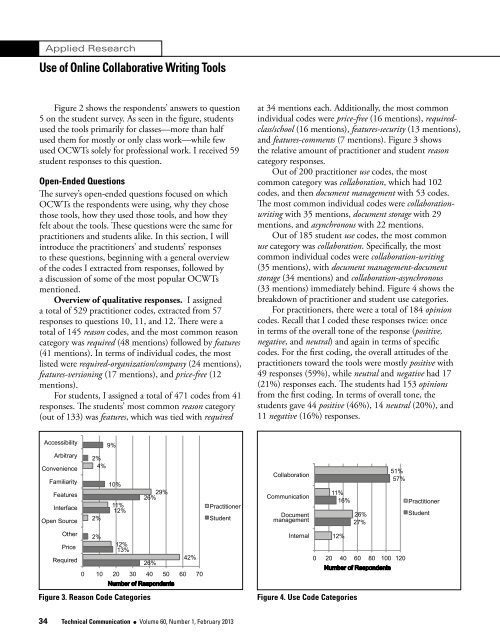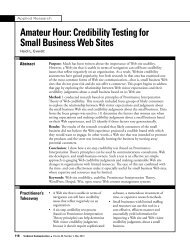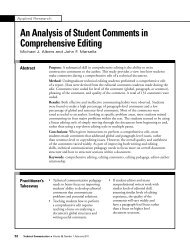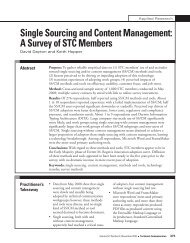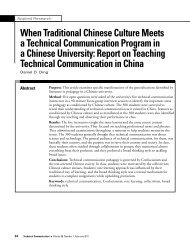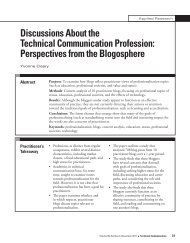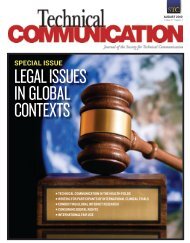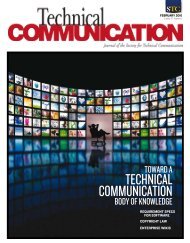The Use of Online Collaborative Writing Tools by Technical ...
The Use of Online Collaborative Writing Tools by Technical ...
The Use of Online Collaborative Writing Tools by Technical ...
You also want an ePaper? Increase the reach of your titles
YUMPU automatically turns print PDFs into web optimized ePapers that Google loves.
Applied Research<strong>Use</strong> <strong>of</strong> <strong>Online</strong> <strong>Collaborative</strong> <strong>Writing</strong> <strong>Tools</strong>Figure 2 shows the respondents’ answers to question5 on the student survey. As seen in the figure, studentsused the tools primarily for classes—more than halfused them for mostly or only class work—while fewused OCWTs solely for pr<strong>of</strong>essional work. I received 59student responses to this question.Open-Ended Questions<strong>The</strong> survey’s open-ended questions focused on whichOCWTs the respondents were using, why they chosethose tools, how they used those tools, and how theyfelt about the tools. <strong>The</strong>se questions were the same forpractitioners and students alike. In this section, I willintroduce the practitioners’ and students’ responsesto these questions, beginning with a general overview<strong>of</strong> the codes I extracted from responses, followed <strong>by</strong>a discussion <strong>of</strong> some <strong>of</strong> the most popular OCWTsmentioned.Overview <strong>of</strong> qualitative responses. I assigneda total <strong>of</strong> 529 practitioner codes, extracted from 57responses to questions 10, 11, and 12. <strong>The</strong>re were atotal <strong>of</strong> 145 reason codes, and the most common reasoncategory was required (48 mentions) followed <strong>by</strong> features(41 mentions). In terms <strong>of</strong> individual codes, the mostlisted were required-organization/company (24 mentions),features-versioning (17 mentions), and price-free (12mentions).For students, I assigned a total <strong>of</strong> 471 codes from 41responses. <strong>The</strong> students’ most common reason category(out <strong>of</strong> 133) was features, which was tied with requiredat 34 mentions each. Additionally, the most commonindividual codes were price-free (16 mentions), requiredclass/school(16 mentions), features-security (13 mentions),and features-comments (7 mentions). Figure 3 showsthe relative amount <strong>of</strong> practitioner and student reasoncategory responses.Out <strong>of</strong> 200 practitioner use codes, the mostcommon category was collaboration, which had 102codes, and then document management with 53 codes.<strong>The</strong> most common individual codes were collaborationwritingwith 35 mentions, document storage with 29mentions, and asynchronous with 22 mentions.Out <strong>of</strong> 185 student use codes, the most commonuse category was collaboration. Specifically, the mostcommon individual codes were collaboration-writing(35 mentions), with document management-documentstorage (34 mentions) and collaboration-asynchronous(33 mentions) immediately behind. Figure 4 shows thebreakdown <strong>of</strong> practitioner and student use categories.For practitioners, there were a total <strong>of</strong> 184 opinioncodes. Recall that I coded these responses twice: oncein terms <strong>of</strong> the overall tone <strong>of</strong> the response (positive,negative, and neutral) and again in terms <strong>of</strong> specificcodes. For the first coding, the overall attitudes <strong>of</strong> thepractitioners toward the tools were mostly positive with49 responses (59%), while neutral and negative had 17(21%) responses each. <strong>The</strong> students had 153 opinionsfrom the first coding. In terms <strong>of</strong> overall tone, thestudents gave 44 positive (46%), 14 neutral (20%), and11 negative (16%) responses.Figure 3. Reason Code CategoriesFigure 4. <strong>Use</strong> Code Categories34 <strong>Technical</strong> Communication l Volume 60, Number 1, February 2013


